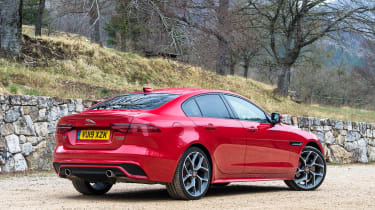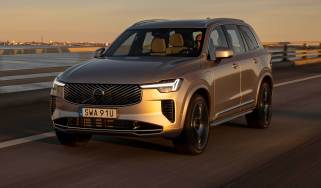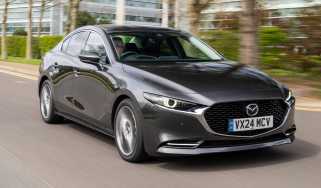Jaguar XE saloon review (2015-2024)
“The Jaguar XE is an excellent rival to German executive saloons but engine choices are now very limited”
Pros
- Low running costs
- Comfortable ride
- Smart interior
Cons
- Small engine range
- Limited rear passenger space
- Smaller boot than rivals
The Jaguar XE represents the British-founded, Indian-owned brand’s second attempt at a compact executive car. Since it launched, it has faced a monumental struggle against the Audi A4, BMW 3 Series and Mercedes C-Class, but a major refresh for 2019 gave the XE more tools than ever to take them on.
The three German brands were first forced to take notice the very day the Jaguar XE was unveiled. Sharing many of its design cues with the popular Jaguar XF, it was quickly apparent the XE would be a strong performer in all key areas. It’s a compact luxury car that’s good enough to tempt customers away from popular German brands without involving any compromises. Other rivals for the XE include the Volkswagen Arteon, Lexus IS and Alfa Romeo Giulia. Its 2019 redesign gave it more assertive looks, with new LED lights and bodywork that seemed to make the XE appear wider and more stylish.
The XE now comes with either an efficient D200 diesel with mild-hybrid tech and rear-wheel drive, or with two petrol engines – the rear-wheel-drive P250 or punchier P300 with all-wheel drive.
The best executive cars on sale
If your priority is efficiency, the diesel XE shouldn’t cost too much to run, thanks to its claimed 57.6mpg economy. Its 128g/km CO2 emissions bring competitive Benefit-in-Kind (BiK) rates for the company-car drivers who make up a large proportion of XE owners.
More reviews
Car trim reviews
In-depth reviews
Used car reviews
The P250 2.0-litre petrol has 246bhp and is rear-wheel-drive – this powertrain gets the XE from 0-60mph in 6.4 seconds. The P300 version of the 2.0-litre petrol has 296bhp and its four-wheel drive means a 0-60mph time of 5.6 seconds but it costs more to run. Like every facelifted Jaguar XE, it comes with an eight-speed automatic gearbox as standard, but four-wheel drive means economy and CO2 emissions take a hit, so it’s not as attractive to company-car drivers.
The XE’s interior is full of character, with design flourishes that help it stand out against rivals. Since the facelift, there's been a real attention to quality too, with more upmarket materials used than before. You can also replace the traditional instrument panel with a configurable 12.3-inch screen as part of the infotainment system that comes as standard in SE trims and above. All versions of the XE get Jaguar’s latest Pivo Pro system, accessed via a 10-inch touchscreen in the centre of the dash.
The list of standard equipment also impresses; DAB radio, Bluetooth connectivity and dual-zone climate control are all included. There are plenty of convenience features, including automatic lights and wipers, cruise control and advanced parking aids.
While interior comfort is a strong suit, the XE isn’t especially generous on space in the rear, with tight leg and headroom for adults. And while it’s hardly mean, the 455-litre boot also falls behind the 480 litres you get in its main rivals.
In independent Euro NCAP crash-testing, the XE earned a five-star rating, with impressive results in each category. Its strong performance was helped by autonomous emergency braking, traffic-sign recognition and lane-keeping assistance technology.
It might be up against some of the world’s toughest rivals, but the Jaguar XE still shines as an impressive all-rounder with plenty of desirable features, particularly after its mid-life facelift. It’s cheaper than many of its rivals, offers reasonable running costs with most engines and is likely to hold its value well.
















